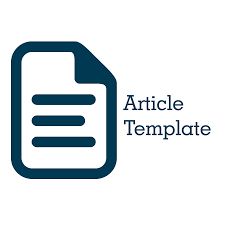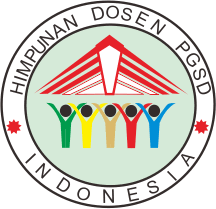Tingkat pemahaman siswa terhadap teks wacana dalam aspek tema dan struktur pada program GLS di sekolah dasar
Abstract
Understanding the content of reading texts is one of the language skills included in reading skills. This study aims to describe the level of ability of fourth grade students in understanding the content of reading texts in the School Literacy Movement program, which was developed by focusing on aspects of the theme and structure of the discourse text. This research is a mix method study. The subjects in this research were fourth grade students and fourth grade teachers at Soropadan Elementary School. Data collection used in this research was tests, interviews with class IV teachers, and document studies. The data analysis technique in this research uses the Miles and Huberman model of interactive data analysis techniques. Data validity testing techniques use triangulation of sources and techniques. Data presentation uses simple descriptive statistics. The results of this study indicate that the percentage obtained in the aspect of identifying the reading theme is 83.92% and 86.60% in the aspect of identifying the reading structure. From the results of the study, it can be concluded that the level of students' understanding of the contents of the reading in the School Literacy Movement program at Soropadan Elementary School is already in the good category. This condition occurs as a result of the activity pattern of the School Literacy Movement at Soropadan Elementary School which has been taking place regularly and continuously.
Keywords
Full Text:
PDFReferences
Suryawati, E., Suzanti, F., Suwondo, S., & Yustina, Y. (2018). The implementation of school-literacy-movement: Integrating scientific literacy, characters, and HOTS in science learning. JPBI (Jurnal Pendidikan Biologi Indonesia), 4(3), 215–224. [2] Rohman, S. (2017). Membangun Budaya Membaca Pada Anak Melalui Program Gerakan Literasi Sekolah. Jurnal Pendidikan Dan Pembelajaran Dasar, 4(1), 156–160. [3] Azis, A. (2018). Implementasi Gerakan Literasi Sekolah Pada Pembelajaran Bahasa Indonesia Di Sekolah Dasar. Jurnal Autentik, 2, 57–64. [4] Azimah, R. (2019). Implementasi Gerakan Literasi Sekolah dalam Pembelajaran di Kelas Tinggi. JURNAL PAJAR (Pendidikan Dan Pengajaran), 3(4), 934–947. [5] Sudarmini, S. (2018). Peningkatan Literasi Siswa: Upaya Sukses Gerakan Literasi Sekolah (GLS). Sniemas Uad, 303–308. [6] Suryawati, E., Suzanti, F., Suwondo, S., & Yustina, Y. (2018). The implementation of school-literacy-movement: Integrating scientific literacy, characters, and HOTS in science learning. JPBI (Jurnal Pendidikan Biologi Indonesia), 4(3), 215–224. [7] Guthrie, J. T., & Humenick, N. M. (2004). Motivating Students to Read: Evidence for Classroom Practices that Increase Reading Motivation and Achievement. In P. McCardle & V. Chhabra (Eds.), The voice of evidence in reading research (pp. 329–354). Paul H. Brookes Publishing Co. [8] Narvaez, D. (2002). Individual differences that influence reading comprehension. In M. Pressley & C. C. Block (Eds.). Reading comprehension instruction (pp. 158-175). New York: Guilford. [9] Petty, W.T. & Jensen, J.M. 1980. Developing Children’s Language. Massachussets: Allyn and Bacon Inc. [10] Riani, N. (2021). Analisis Kemampuan Membaca Pemahaman dalam Pembelajaran Bahasa Indonesia pada Siswa Kelas V SD Negeri 6 Jatisari Kecamatan Kedungreja Kabupaten Cilacap Tahun Ajaran 2020/2021. [11] Salsabila, A., Wulan, N. S., & Rosmana, P. S. (2021). Analisis Kemampuan Membaca Pemahaman Siswa Kelas IV Sekolah Dasar. In Renjana Pendidikan: Prosiding Seminar Nasional Pendidikan Dasar (Vol. 2, No. 1, pp. 455-465). [12] Laily, I. F. (2014). Hubungan kemampuan membaca pemahaman dengan kemampuan memahami soal cerita matematika sekolah dasar. Eduma: Mathematics Education Learning and Teaching, 3(1). [13] Meliala, J. (2021). Analisi Kecepatan Membaca Dan Keterpahaman Siswa Terhadap Isi Bacaan Pada Mata Pelajaran Bahasa Indonesia Kelas V SD Negeri 060936 Medan Johor Tahun Ajaran 2020/2021 (Doctoral Dissertation, Universitas Quality). [14] Mirasanthi, K. G., Suarjana, I. M., & Garminah, N. N. (2016). Analisis kemampuan siswa dalam membaca pemahaman pada wacana narasi kelas V SD Negeri 1 Penarukan. Mimbar PGSD Undiksha, 4(1). [15] Khasanah, A. & Cahyani, I. (2016). Peningkatan Kemampuan Membaca Pemahaman dengan Strategi Question Answer Relationships (QAR) pada Siswa Kelas V Sekolah Dasar. Jurnal Pedagogik Pendidikan Dasar, 4(2), 161-175.
Refbacks
- There are currently no refbacks.



